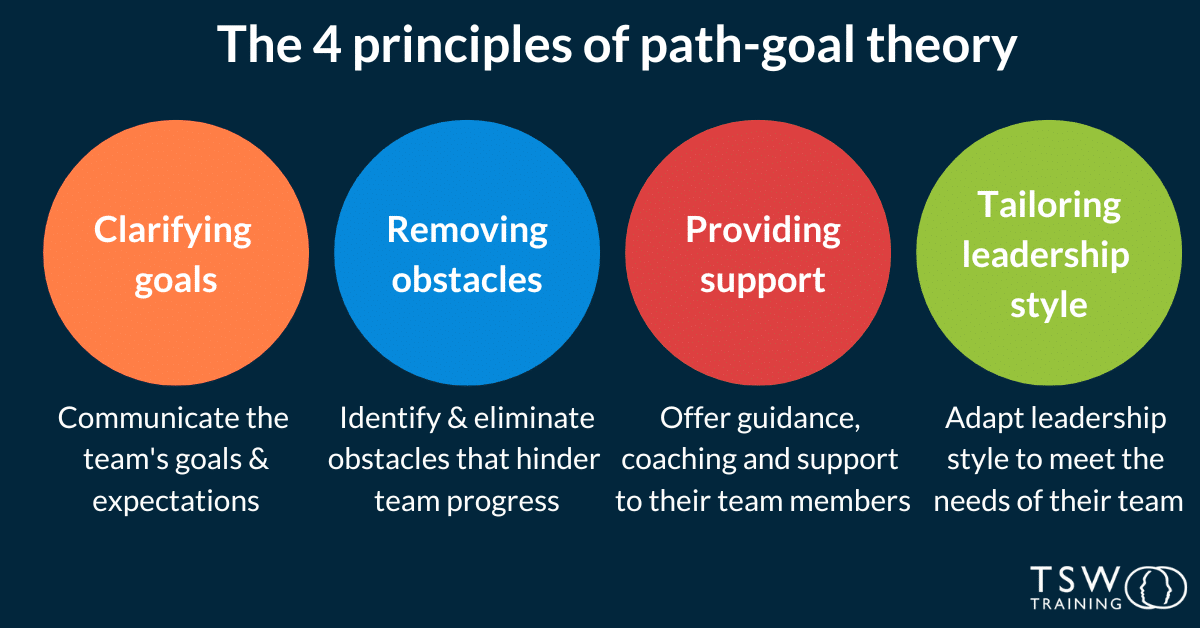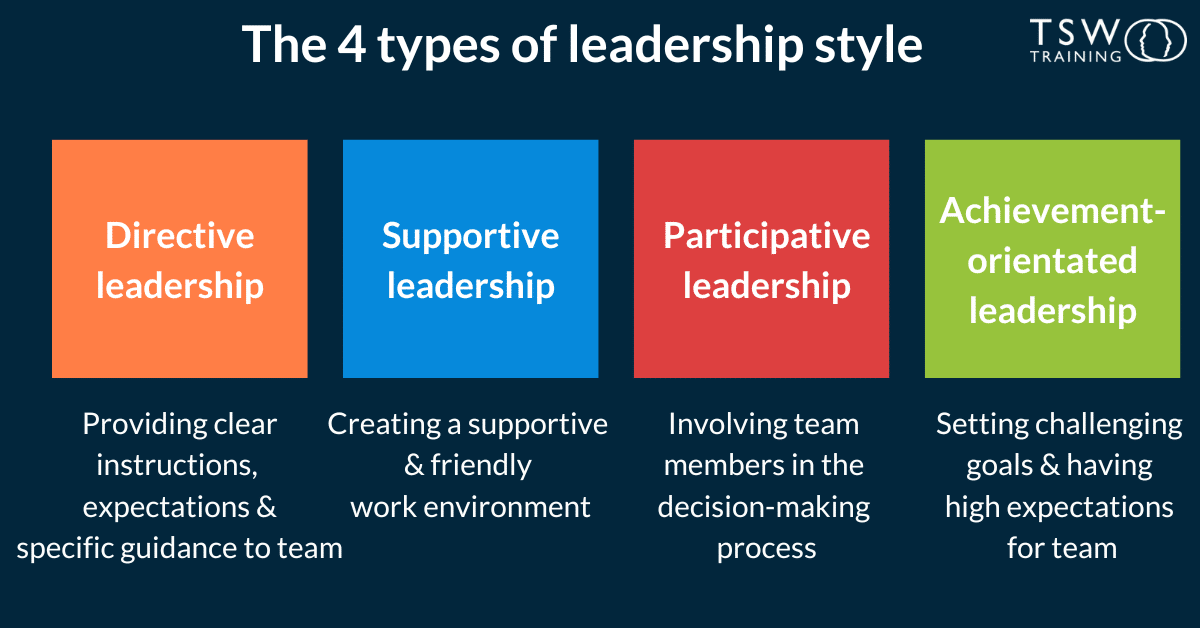Robert House’s path-goal theory provides a framework for understanding how leaders can influence and motivate their teams. This theory suggests that leaders can enhance motivation and performance by clarifying goals, removing obstacles and providing support to their team members.
By adopting the key principles of the path-goal theory, and adapting their leadership style to the situation at hand, managers and leaders can effectively boost team motivation and optimise performance.
Here we’ll examine the core concepts of the path-goal theory, outlining strategies for leaders to apply its principles to inspire and empower their teams.
⏰Key points:
- Path-goal theory aims to optimise team satisfaction, motivation and performance. Leaders help their team achieve this by defining clear goals, providing support, and removing obstacles on the path to that goal.
- Four different leadership styles are identified in the theory, which leaders should tailor to the specific circumstances and team characteristics. These are directive, supportive, participative and achievement-orientated leadership.
- Practical ways in which the theory can be applied include setting SMART goals, personalising support to individuals, communicating transparently, and a clear system of recognition and reward.
What is path-goal theory?
Path-goal theory was first introduced by Robert House in 1971, and later revised in 1996. It states that leaders’ behaviour and leadership style influences their subordinates’ characteristics – namely their satisfaction, motivation and performance.
We won’t be using the term ‘subordinates’, as we prefer ‘employees’, ‘team members’ and similar terms. It’s also worth noting that House didn’t view leaders and subordinates in terms of power. Rather, he argued that effective leaders clear the path for their employees to follow, removing obstacles and challenges.
In order to achieve this, according to this theory, leaders should adopt specific behaviours and strategies based on the characteristics of their team and the environmental context. The theory emphasises that leaders should clarify goals, provide necessary guidance and support, and remove obstacles – ensuring that team members feel confident in their ability to succeed.
What are the principles of path-goal theory?
The principles of House’s path-goal theory are as follows:
#1. Clarifying goals
Leaders must clearly communicate the team’s goals and expectations, providing a sense of direction and purpose. By ensuring that team members understand their roles and the desired outcomes, leaders can align individual efforts with the overarching objectives.
#2. Removing obstacles
Leaders should identify and eliminate obstacles that hinder team progress. This may involve addressing resource constraints, providing necessary training and development opportunities, or advocating for the team within the organisation. By removing barriers, leaders create a supportive environment that enhances team members’ motivation and performance.
#3. Providing support
Leaders should offer guidance, coaching and support to their team members. This involves providing feedback, facilitating skill development and offering assistance when needed. Supportive leaders build trust and foster a positive working relationship, in turn enhancing team members’ confidence and motivation.
#4. Tailoring leadership style
Leaders should adapt their leadership style to meet the needs of their team members and the specific situational context. We’ll look at these styles in a moment. But in short, leaders must be flexible and responsive in their leadership style to optimise the team’s motivation and performance.
What are the four types of leadership style?
In his path-goal theory, House identified four distinct leadership behaviours, which are outlined below. But before we go on, it’s worth mentioning that adopting a leadership style doesn’t have to be to the exclusion of others.
Depending on the situation, it may be appropriate to mix and match. This might be the case when a team comprises members with different levels of skill and experience, for instance.
#1. Directive leadership
This style involves providing clear instructions, expectations and specific guidance to team members. Leaders using this style take charge, define goals and let the team know what’s expected of them.
This approach also promotes transparency, with objectives and rewards – including pay rises and promotions, for example – being clearly defined. They then closely supervise and monitor the team’s progress. The purpose is to reduce ambiguity, and provide clarity and structure – thereby enhancing performance.
Directive leadership is often best for less experienced team members, and those who need a bit of direction.
#2. Supportive leadership
This style focuses on creating a supportive and friendly work environment. Leaders who adopt this style are approachable and empathetic, displaying concern about their employees’ wellbeing. As such, they provide emotional support and listen to the team’s concerns, all the while addressing their needs. The purpose is to enhance job satisfaction, increase team members’ self-esteem, and generally create a positive atmosphere.
As such, this style is best for team members who need a bit of a confidence boost.
#3. Participative leadership
This style involves involving team members in the decision-making process, allowing them input in how to reach their task goals. Leaders using this style consult with their team, seek their contribution, and weigh up their suggestions before making decisions. Here the team’s opinions and contributions are valued. The purpose is to increase individuals’ involvement, commitment and motivation by empowering them, making their input feel worthwhile.
This approach can be especially useful for leaders if team members might provide good insights, such as when they have specialist knowledge.
#4. Achievement-orientated leadership
This style focuses on setting challenging goals and having high expectations for team members. Those using this style encourage their employees to strive for excellence, continually improve their performance and meet ambitious targets. Leaders provide feedback, recognise achievements and promote a sense of accomplishment. The purpose is to motivate team members to perform at their best, enhancing confidence in their abilities.
This style is well suited to team members who are good at problem solving, and working on their own steam.
How can path-goal theory be applied in the workplace?
So how can this be applied in practice? Here are some examples of how path-goal theory might inform your day-to-day strategies in the workplace.
#1. Goal clarity and alignment
Leaders should clearly define team goals, ensuring that they’re specific, measurable, attainable, relevant and time-bound (SMART).
You should communicate these goals effectively, emphasising their importance and relevance to the team’s overall purpose.
By aligning individual goals with the overarching team objectives, you can create a sense of unity and motivation.
#2. Personalised support
Leaders should understand the unique needs and capabilities of each team member. As such, it’s important to provide tailored support accordingly.
This may involve coaching or mentoring, for example. You could also provide resources and training to help team members overcome challenges and develop their skills.
By offering personalised support, leaders demonstrate commitment to the growth and success of each team member.
#3. Transparent communication
Open and transparent communication helps leaders cultivate trust and motivate their teams. Information should be shared regarding the team’s progress and challenges, and also regarding developments in the organisation.
In addition, two-way communication should be encouraged. You can benefit from actively listening to team members’ ideas, concerns and feedback. Transparent communication promotes a sense of involvement and fosters collaboration, which will ultimately increase motivation.
#4. Empowerment and autonomy
Leaders should empower team members by delegating authority and providing autonomy whenever possible. This can involve trusting team members to make decisions and take ownership of their work.
By granting autonomy, you can promote a sense of ownership and responsibility among your employees.
#5. Recognition and reward
It’s important to acknowledge and appreciate the efforts of your team members. Recognising and rewarding individual and collective achievements will reinforce positive behaviour, and encourage continued high performance.
Leaders can implement a system of rewards and recognition that aligns with the goals and values of the team, ensuring fairness and equity in the distribution of rewards.
#6. Continual feedback and coaching
When it comes to maintaining motivation and improving performance, feedback is key. Leaders should provide constructive feedback, highlighting areas of improvement and recognising strengths.
You should also offer guidance and coaching to help team members develop their skills and overcome obstacles.
#7. Create a positive work environment
A positive work environment promotes collaboration, respect and psychological safety. To achieve this, you can encourage open communication, support teamwork, and address conflicts or issues promptly.
A positive work environment enhances team members’ satisfaction and engagement, ultimately leading to improved performance.
#8. Development opportunities
It’s a good idea to provide opportunities for team members to enhance their skills and knowledge through training, workshops or conferences, for example. By investing in their professional growth, you can demonstrate your commitment to the team’s success.
This has several benefits. For a start, you motivate team members to perform at their best. Plus development opportunities contribute to employee retention and loyalty.
#9. Lead by example
As a leader, it’s crucial to embody the behaviours and values that you expect from your team members. This is really leadership 101. Demonstrating a strong work ethic, integrity and positive attitude will generate the same in return.
Leaders who lead by example inspire and motivate their teams to follow suit, creating a culture of excellence and high performance.
Does House’s path-goal benefit leaders and managers?
While doubtlessly useful in helping leaders understand how they can motivate their teams, the theory is not without its drawbacks.
It’s drawn criticism for lack of clear guidelines, meaning it may not always be obvious how to apply it in practice. It also doesn’t account for individual complexity. People aren’t always easily pigeon-holed, and may not fit comfortably into the four leadership styles prescribed.
Moreover, it’s been argued that it overemphasises leader behaviour. Because the theory primarily focuses on leader behaviours and their impact on motivation and performance, it may overlook other important factors.
For example, employee characteristics, team dynamics and organisational culture may also have a significant influence on motivation and performance.
Nonetheless, House’s path-goal theory can provide valuable insights into how leaders may enhance team motivation and performance. By clarifying goals, removing obstacles and providing support – while also adapting their leadership style – leaders can help to promote a motivating work environment that empowers individuals to achieve their best.
Find out more about how to motivate a team and build trust.









